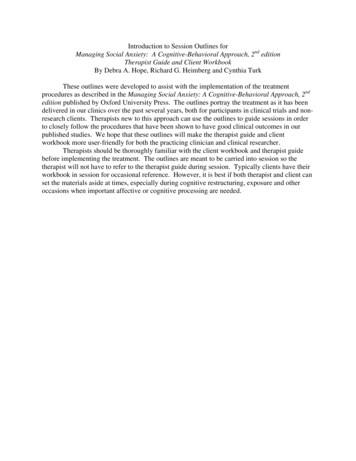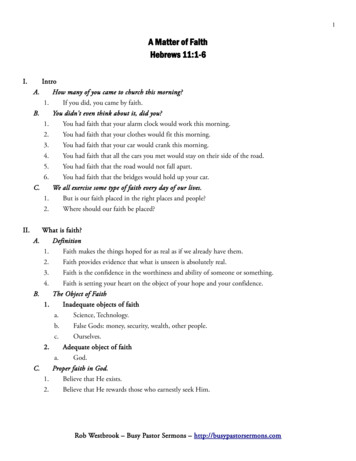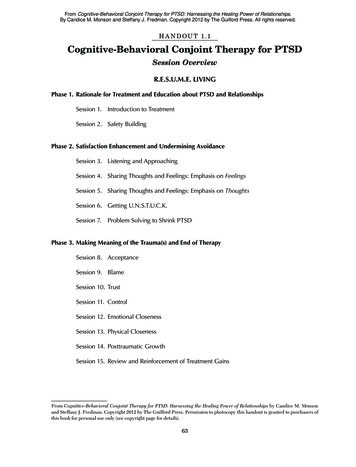
Transcription
Introduction to Session Outlines forManaging Social Anxiety: A Cognitive-Behavioral Approach, 2nd editionTherapist Guide and Client WorkbookBy Debra A. Hope, Richard G. Heimberg and Cynthia TurkThese outlines were developed to assist with the implementation of the treatmentprocedures as described in the Managing Social Anxiety: A Cognitive-Behavioral Approach, 2ndedition published by Oxford University Press. The outlines portray the treatment as it has beendelivered in our clinics over the past several years, both for participants in clinical trials and nonresearch clients. Therapists new to this approach can use the outlines to guide sessions in orderto closely follow the procedures that have been shown to have good clinical outcomes in ourpublished studies. We hope that these outlines will make the therapist guide and clientworkbook more user-friendly for both the practicing clinician and clinical researcher.Therapists should be thoroughly familiar with the client workbook and therapist guidebefore implementing the treatment. The outlines are meant to be carried into session so thetherapist will not have to refer to the therapist guide during session. Typically clients have theirworkbook in session for occasional reference. However, it is best if both therapist and client canset the materials aside at times, especially during cognitive restructuring, exposure and otheroccasions when important affective or cognitive processing are needed.
Therapist Guide for Managing Social Anxiety: A Cognitive Behavioral Approach, 2ndeditionChapter 5PSYCHOEDUCATION, PART 1: BACKGROUND ON SOCIAL ANXIETYTimeline: Typically one sessionReading: Chapter 1 in Client WorkbookPhotocopies needed from Client Workbook:Pros and Cons of Working on My Social Anxiety (Worksheet 1.1 in ClientWorkbook)Physical Symptoms of Social Anxiety that I Experience (Worksheet 2.1 in ClientWorkbook)Thoughts Related to an Anxiety-Provoking Situation (Worksheet 2.2 in ClientWorkbook)Session Outline for Chapter 1 in Client WorkbookI. Set agenda for sessionA. Chapter 1 in Client Workbook1. Basic information about social anxiety2. Information about how this treatment program works3. Getting ready to start treatmentB. Any other matters that need to be handled for a given clientII. Social anxiety (feeling nervous around other people) is a normal part of life; illustratewith case vignette of normal levels of social anxietyA. Vignette from Client Workbook: Nicole is starting new job and must make apresentation to the manager’s meeting1. Anticipatory anxiety symptoms: questioning whether she really wantspromotion, “butterflies in stomach,” feeling tense2. Anxiety increases as begins presentation: palpitations, sees faceslooking at her, stumbles over words initially3. Uses good coping statementsa) “I’m prepared.”b) “No one expects me to be perfect on the first day.”4. As presentation continues, anxiety decreases as she notices safetycues such as everyone listening attentively5. Positive outcome after presentationa) Nicole wonders why she was so anxious before presentation as itwent wellb) Nicole feels more optimistic about the job after facing her fearsB. Nicole’s experience is an example of social anxiety1. Public speaking is a commonly feared situation2. Nicole’s symptoms are consistent with what people typically report3. Normal social anxiety is experienced by people in unfamiliar or
infrequently occurring situationsa) Speaking in front of a groupb) Meeting with a new boss or job interviewc) Going to a new class or job where you do not know anyoned) Getting to know a potential dating partnerC. Typically social anxiety is unpleasant but not unmanageable and decreasesquickly once the situation is facedIII. Clinically severe social anxiety is different than normal levels of social anxiety;illustrate with case vignette of social anxiety disorderA. Vignette from Client Workbook: Cory is a 30-year-old man in his first romanticrelationship who is meeting his prospective in-laws for the first time1. Serious anticipatory anxietya) Started a week before the dinner and increased as timeapproachedb) Tension and worry about the dinner dominated his experienceduring the preceding weekc) Nausead) Worried about making a bad impression on her parents thatwould embarrass Jodi and cause relationship to ende) Anxiety interferes with concentration while driving to restaurant2. Anxiety very severe as he meets Jodi’s parents and continues to be aproblem throughout dinnera) Severe palpitationsb) Sweaty palmsc) Believes father is evaluating him negatively because he looksanxiousd) Trouble concentrating on conversatione) Escapes before coffee and dessert by making excuses3. Later Jodi said that she thought the evening went well; her parentsnoticed Cory’s anxiety but did not draw negative conclusionsIV. Compare and contrast normal and clinically severe social anxiety as presented inthe vignettes to illustrate that social anxiety exists on a continuum of severityA. Differences in intensity of symptomsB. Differences in duration of anticipatory anxietyC. Differences in how much symptoms interfered with functioningD. The important question is not whether someone experiences social anxiety ornot (most of us do), but how much and how often we experience social anxietyE. Social anxiety exists on a continuum of less severe to more severe1. Contrast with a broken arm, which is an all-or-nothing event2. Re-examine both scenarios by describing how the anxiety could havebeen more or less severe in each set of circumstancesV. Define social anxiety, social phobia, and social anxiety disorderA. Social anxiety disorder vs. social phobia1. Social anxiety disorder is new name for what has traditionally beencalled social phobia2. In Client Workbook, use “social phobia” in Chapter 9 for specific social
fears, such as one’s hand shaking while writing in front of othersB. DSM-IV-TR definition of social anxiety disorder1. Core features: fear of being negatively evaluated by others, doingsomething humiliating or embarrassing in front of others, others seeingone’s anxiety2. Situations in which someone is concerned about what others think varywidely; common situations include:a) Public speakingb) Conversations with unfamiliar peoplec) Datingd) Being assertivee) Eating or drinking in front of other peoplef) Being the center of attentiong) Talking with supervisors or other authority figuresh) Urinating in a public bathroom (usually only men)i) Intimate sexual situations3. Regardless of the specific situation, persons with social anxiety disordershare a common fear that other people will think poorly of them4. Other criteriaa) Realizing that the fear is excessiveb) Avoiding the situations that cause anxiety or enduring themdespite high levels of anxietyc) Social anxiety disorder must interfere with the person’s life inimportant ways or there must be great distress at having the fearsC. Social anxiety disorder versus social anxiety1. Social anxiety disorder is diagnostic label with specific DSM-IV-TRcriteria2. Social anxiety refers to the distress a person might experience wheninteracting with or performing in front of other peoplea) Social anxiety is a normal experience that may not be a problemb) More severe social anxiety, or if it occurs in many situations,might become (or be labeled as) social anxiety disorderc) If social anxiety is a problem, even if one does not technicallymeet criteria for the disorder, this treatment is probably appropriateVI. Help client consider how his/her concerns could be described as social anxiety,social anxiety disorder, and/or social phobiaA. Compare how client’s experience relates to vignettesB. Watch for any doubts that social anxiety describes what client is experiencing1. Separate doubts about whether treatment can be successful fromagreement with therapist on conceptualization of the presenting problem2. Do not move on until some level of agreement that client is experiencingsocial anxietyVII. Evidence for effectiveness of the treatment programA. No guarantees but research suggests that CBT is helpful for most people withsocial anxiety disorderB. Research data
1. Comparison of this treatment to educational-supportive group therapya) 12 weeks of group treatmentb) 75% of clients in cognitive-behavioral treatment classified as“improvers,” indicating major improvement in symptoms and subclinical severity of social anxiety and avoidancec) Greater percentage of “improvers” than in credible educationalsupportive group treatmentd) Six month post-treatment follow-up – most judged to be improvede) At 5-year follow-up, still doing well and better than educationalsupportive group treatment2. Dozens of other studies from around the world with hundreds of clientsfound CBT to be very helpful for social anxiety3. Overall, in Heimberg, Hope, and colleagues’ research, about 80% of theparticipants are classified as “improvers” or “responders” to treatment(similar percentages in group versus individual treatment)4. Comparison of cognitive-behavioral treatment to phenelzine (Nardil), ahighly studied medication for social anxiety disordera) Phenelzine and CBT about equally effective but medicationworks fasterb) About 50% relapse when they go off phenelzine (similar to ratesfor more recently developed medications, such as the selectiveserotonin reuptake inhibitors, 30-60%)c) Individuals in CBT do not tend to relapse when therapy ends5. Comparison of individual cognitive-behavioral treatment (using thisworkbook) to a minimal contact delayed treatment control conditiona) 16 sessionsb) Individuals in immediate treatment substantially improvedc) Individuals in delayed treatment neither improved nordeterioratedd) Fewer withdrew from treatment (less than 10%) than in moststudies using group format (about 25%)e) Gains made during treatment were maintained at 3-month followup assessmentVIII. Discussion of clients’ motivation for change using motivational interviewingtechnique.A. Pros and cons for changing and staying the same1. Reasons you might have for not changing because those issues mightget in the way of making progress in treatment2. Reasons that you want your life to be differentB. Worksheet 1.1 Pros and Cons of Working on My Social Anxiety1. List the Pros and Cons of working on social anxietya) How is social anxiety interfering in your life or keeping you fromdoing the things you want to do?b) What obstacles might there be to following through withtreatment or being successful at it?2. List the Pros and Cons of not working on social anxiety (and staying the
same)3. Additional issues to considera) What the client’s life may be like in 5 or 10 years if steps are nottaken to change nowb) What the client could have in his or her life (i.e., personal, family,work) if social anxiety were no longer standing in the wayIX. How clients can get the most out of this programA. Seriously invest in change1. Personal change is hard work2. Need to set aside time at least several times a week to work on socialanxiety3. Need to make an emotional investment by being willing to experienceanxiety4. Share slogan: Invest Anxiety in a Calmer Future5. Need to make an emotional investment by being honest with self andtherapist and thoughts and fearsB. Do the exercises carefully and practice procedures frequentlyC. Persevere!1. Keep working even if the benefits are not immediately apparent; smallimprovements lead to larger onesD. Avoid “disqualifying the positive” as socially anxious individuals are often theirown worst criticsE. Be willing to try new ways and give up old ways of dealing with social anxiety1. Must be willing to give up drugs or alcohol to help control your anxiety2. Must be willing to give up PRN (“as needed”) prescription medication foranxiety when doing exposuresF. Emphasize that whether this program works for a given client is under his/hercontrol. If clients commit the time and energy, they are likely to see benefits.X. Overview of This Treatment ProgramA. Continue education about social anxietyB. Learn to analyze anxietyC. Learn cognitive restructuring skills to help control anxietyD. Gradually begin to practice situations that are difficult, starting within sessionand with easier situations firstE. Learn to apply cognitive restructuring skills to manage anxiety in fearedsituationsF. Learn how to consolidate gains and prepare to finish treatment with thetherapistXI. Assign Homework:A. Review Chapter 1 and read Chapter 2B. Complete the following forms from Chapter 21. Physical Symptoms of Social Anxiety that I Experience (Worksheet 2.1in Client Workbook)2. Thoughts Related to an Anxiety-Provoking Situation (Worksheet 2.2 inClient Workbook)
Therapist Guide for Managing Social Anxiety: A Cognitive Behavioral Approach, 2ndeditionChapter 6PSYCHOEDUCATION, PART 2: UNDERSTANDING THE NATURE OF SOCIALANXIETYTimeline: Typically up to one sessionReading: Chapter 2 in Client WorkbookPhotocopies needed from Client Workbook:Monitoring the Three Components of Social Anxiety (Worksheet 2.3 in ClientWorkbook)Worksheet for Reactions to Starting This Treatment Program (Worksheet 2.2 inClient Workbook)Brainstorming for Your Fear and Avoidance Hierarchy (Worksheet 3.1 in ClientWorkbook)Session Outline for Chapter 2 in Client WorkbookI. Agenda Setting and Review of HomeworkA. Developing a common language to talk about social anxietyB. Answer questions client may have from previous sessionC. Reiterate the importance of commitment between sessions1. Did client complete reading assignment?2. Did client complete (attempt) assigned forms?B. Homework will be reviewed as work through session materialII. Developing a common language to understand anxiety: The three components ofanxietyA. Physiological Component – feelings in the body when one is anxious1. Review Table 2.1 in Client Workbook for list of physiological symptoms2. Symptoms may occur for reasons other than anxietya) Nausea may be the result of anxiety or a spicy mealb) Symptoms may indicate a medical problem under somecircumstances(1) Chest pain can mean a heart problem, stomach distresscan mean an ulcer(2) If symptoms occur only when frightened or worried aboutsomething, then probably part of anxiety, not a physicalproblem or disease3. Review panic attack symptoms in Table 2.2 of Client Workbooka) One third of the general population and 50% of people with socialanxiety disorder have experienced a panic attackb) Need four of the 13 symptoms that come on quickly and peakwithin 10-15 minutes
(1) Last two symptoms are cognitive, not physiological,symptoms(2) Intensity of the symptoms can be frightening, and peopleoften worry they are losing their mind or having a heartattackc) If client has panic attacks and they occur only in the socialsituations, then this treatment should be helpful for the attacks4. Review client’s physical symptoms using Worksheet 2.1 in the ClientWorkbook.B. The cognitive component of anxiety1. “Cognitive” is psychologists’ word for thoughts or thinking2. Using the worksheet in Worksheet 2.2 in the Client Workbook, elicit andreview client’s thoughts during the same situations used to elicitphysiological symptoms3. Socially anxious people usually just accept thoughts without questioningwhether they are true or realisticC. The behavioral component of anxiety1. The behavioral component has two partsa) What a person does in the anxiety-provoking situation, forexample:(1) Poor eye contact(2) Shuffling feet(3) Nervous gesturesb) Avoidance of anxiety-provoking situations(1) Can be complete avoidance (not attending a party) ormore subtle avoidance (attending the party but only talkingwith familiar people)(2) Safety behavior: a form of subtle avoidance thatincludes anything the person feels they must do to survivean anxiety-provoking situation(a) gripping a glass tightly so hand tremors are notvisible(b) wearing a shirt that will not show perspiration(c) avoiding certain conversation topics(3) Avoidance decreases anxiety in the short term(a) Ask “Is there anything that you feel you shouldhave done but you did not do because of youranxiety?”(b) Decrease in anxiety when escaping an anxietyprovoking situation reinforces the avoidance(c) Becomes more likely that the person will avoidsimilar situations in the future(4) Avoidance is a poor long-term solution for coping withanxiety(a) Guilt, frustration, and other negative feelingstypically occur when one avoids an anxiety-provoking
situation(b) Avoidance can greatly interfere with functioning(c) Avoidance keeps a socially anxious person fromgetting over his/her anxiety and finding out whetherhe/she would be able to cope if the situation had notbeen avoided(d) Avoidance leads to missed opportunities, activitiesthat the person never started, as well as those thatwere escapedIII. The interaction of the physiological, cognitive, and behavioral componentsA. The three components interact; change in one causes increases or decreasesin the othersB. Downward spiral of anxiety – illustrate interaction of components with a casevignette1. Cathy is a clerical worker who has not received an expected raisedespite good evaluations2. Decides to speak with supervisor about a raise at the end of a meetingabout another matter3. Anticipatory anxiety – follow downward spiral in Figure 2.3 in ClientWorkbooka) Cognitive: “Something must be wrong with my work, or theywould give me a raise”b) Physiological: Tightness in stomach, shoulder and back musclesare tensec) Behavioral: Knocks stack of files off desk due to distraction ofanxietyd) Cognitive: “I’m so incompetent! No wonder they won’t give me araise”e) Physiological: Palpitations, ache in back of neckf) Behavioral: Cannot sit still, keeps jumping out of seat to dosomethingg) Cognitive: “If I deserved a raise, I would have one” and “Askingfor a raise is too ‘pushy’”4. Anxiety in the meeting with supervisora) Physiological: Shortness of breath, shaking handsb) Cognitive: “She’ll laugh when I ask for a raise because I’ll lookridiculous since I’m so nervous”c) Behavioral: Foot tappingd) Physiological: Pounding hearte) Cognitive: “I’m too nervous to talk with her. I won’t do it right andI’ll get fired.”f) Behavioral: Leaves meeting without asking for a raiseg) Physiological: Heart rate decreases, muscles relaxh) Cognitive: “I’m such a loser! I don’t deserve a raise anyway.”i) Avoidance leads to negative outcome(1) Feel frustrated, angry, sad, depressed, etc.
(2) Still does not have the deserved raiseD. Goal of treatment:1. First, learn to recognize downward spiral of anxiety2. Second, gain tools to learn how to interrupt the downwardIV. Rationale for 3 components of treatment (systematic graded exposure, cognitiverestructuring, and homework assignments)A. Systematic Graduated Exposure1. Overcoming fears means one must eventually face them, i.e., exposure2. Graduated exposure means starting with easier situations and workingup to harder ones3. In-session exposures are a unique aspect of this treatment programa) Provide an opportunity to practice and get feedbackb) Can work on situations that are feared but unlikely to happen inreal life4. Introduce graph in Figure 6.1 of the Therapist Guide, drawing graph forclienta) Introduce X and Y axis of the graphb) Draw line representing client's belief (that anxiety will continueincreasing)c) Draw vertical line representing escape then anxiety patternwhen escape occursd) Draw line illustrating habituation.e) Help client see that avoidance, such as Cathy chose, keeps onefrom finding out what happens to anxiety.5. Three ways exposure is helpful in overcoming social anxietya) Physical symptoms habituate(1) Habituation is a normal bodily process in whichphysiological arousal levels off and then decreases over time(2) Habituation also occurs with repeated practice(3) Clients may not have experienced habituation becausethey did not stay in situation long enough(4) Eventually clients will learn to trust habituation processesand realize the anxiety will decrease if they stay in thesituationb) Exposure allows rehearsal of behavioral skills in a safeenvironmentc) Exposure provides an opportunity to test dysfunctional beliefsB. Cognitive Restructuring1. A set of procedures that attacks dysfunctional thinking by systematicallyanalyzing anxiety-related self-statementsa) Cognitive restructuring is not replacing bad thoughts with positivethoughts or stating affirmationsb) Cognitive restructuring techniques involve testing beliefs,assumptions, and expectations and see if they really make senseor are helpful
2. Cognitive restructuring helps decrease physiological arousal by makinga more realistic assessment of the danger in a situation3. Cognitive restructuring helps the behavioral component of social anxietyin two waysa) Less dysfunctional thinking will leave more cognitive capacity tohandle the complexities of social interactionb) Changing dysfunctional beliefs will decrease avoidance(1) This leads to more opportunity for more positiveexperiences(2) Positive experiences will further change dysfunctionalthoughtsC. Homework Assignments1. Homework transfers what is being learned in therapy sessions to theperson’s daily life2. Assignments includea) Initially reading or monitoring some aspect of client’s anxiety orbehaviorb) Later assignments involve graduated exposure to fearedsituations outside of the session combined with cognitiverestructuring3. Three important aspects of homeworka) Assignments are negotiated between therapist and client soclient should be honest about what he/she believes can or will bedoneb) Homework does not need to be done perfectly to be successful ifa good effort has been madec) It is essential to do the cognitive restructuring exercises, not justthe exposures, to assure successV. Assign Homework:A. Complete Monitoring the Three Components of Social Anxiety (Worksheet 2.3in Client Workbook)1. If necessary, explain how to use form2. If anxiety-provoking situation does not arise, imagine a recentexperience with social anxiety and complete the formB. Complete Worksheet for Reactions to Starting This Treatment Program(Worksheet 2.4 in Client Workbook)C. Read Chapter 3 of Client WorkbookD. Complete Brainstorming for Your Fear and Avoidance Hierarchy (Worksheet3.1 in Client Workbook)
Therapist Guide for Managing Social Anxiety: A Cognitive Behavioral Approach, 2ndeditionChapter 7PSYCHOEDUCATION, PART 3: MONITORING PROGRESS AND THE FEAR ANDAVOIDANCE HIERARCHYTimeline: Typically one sessionReading: Chapter 3 in Client WorkbookPhotocopies needed from Client Workbook:Worksheet for Reactions to Starting This Treatment Program (Worksheet 2.2 inClient Workbook)Social Anxiety Session Change Index (SASCI)Weekly Social Anxiety Session Change GraphBrainstorming for Your Fear and Avoidance Hierarchy (Worksheet 3.1 in ClientWorkbook)SUDS Anchor Points (pp. 52)Fear and Avoidance Hierarchy (Worksheet 3.2 in Client Workbook; one copy insession, two additional copies after situations are filled in but before SUDS andavoidance ratings are completed, and one additional copy after anxiety andavoidance ratings are completed)Monitoring the Three Components of Social Anxiety (Worksheet 2.3 in ClientWorkbook)Where Did My Social Anxiety Come From? (Worksheet 4.1 in Client Workbook)Session Outline for Chapter 4 in Client WorkbookI. Review homework and set agendaA. Review Worksheet for Reactions to Starting this Treatment Program(Worksheet 2.4 in Client Workbook)1. A few doubts are normal2. Address more significant doubts by reviewing relevant material in thefirst two chapters of the Client WorkbookB. Assure that client can identify the three components of anxiety inhis/her own experience1. Address any problems with compliance or completion of the homework2. If assignment not done, do so in session before continuing onII. Monitoring progressA. Monitor progress in treatment(1) Know if treatment is working(2) Help overcome discouragement if progress feels slow or there is asetbackB. Review instructions for the Social Anxiety Session Change Index (SASCI)(1) Four items regarding anticipatory anxiety of or in social/performancesituations, avoidance of social/performance situations, concern over doingor saying something embarrassing or humiliating in front of others or being
negatively evaluated, and interference in daily activities as a result ofanxiety about social/performance situations(2) The client should rate how he or she is feeling that day, compared tohow he or she was doing before beginning treatmentIII. Develop individualized Fear and Avoidance HierarchyA. Describe and explain rationale1. Rank ordered list of situations that evoke social anxiety2. Rationalea) Used to understand what makes a situation more or less anxietyprovokingb) Helps guide selection of therapeutic exposuresc) Used to assess progress in treatmentB. Step 1: Brainstorming1. Use Worksheet 3.1 in Client Workbook to record list of 8-10 situationsthat might appear on the hierarchya) Integrate client’s experience completing this form for homeworkinto this discussion2. Situations can describe a specific event (“attending high schoolreunion”) or a more general category of social event (e.g., “conversationswith strangers”)3. Include situations that evoke mild, moderate, and severe anxiety4. Emphasize situations that the client would like to address in treatmentC. Step 3: Discovering the Dimensions that Make a Situation Easier or Harder forYou1. Examine the list to identify situational dimensions that increase ordecrease the difficulty2. This process may yield additional situations or other refinements to thelistD. Step 4: Rate Each Situation For Fear It Evokes And The Likelihood You WillAvoid It1. Explain fear (SUDS) ratingsa) Wolpe and Lazarus’ Subjective Units of Discomfort Scale(SUDS)b) 0-100 scale, higher numbers indicate more discomfort or anxiety– scale appears on p. 52 of Client Workbookc) Subjectively define ratings of 0, 25, 50, 75, and 100 by identifyinga situation that matches each description and recording it in ClientWorkbook on pages 53-54(1) 0 no anxiety. Not necessarily happy but calm andrelaxed(2) 25 alert but able to cope. A little “hyped up”(3) 50 anxiety definitely bothersome, some difficultyconcentrating(4) 75 extreme discomfort and thoughts of avoiding orescaping(5) 100 worst anxiety has experienced or can imagine
experiencing2. Explain avoidance ratings on 0 – 100 scale with higher numbersindicating greater avoidance – scale appears on p. 55 of Client Workbooka) Rating behavior – whether or not avoids the situationb) Virtually all situations can be avoided, although sometimes costis high (e.g., loss of job)c) Avoidance can be subtle, i.e., entering a situation then avoidingits anxiety-provoking aspects (e.g., attending a party but onlytalking with familiar people)3. Complete SUDS and avoidance ratings for each situationE. Step 2: Rank Ordering the Situations1. Rank order braining storming list with 1 most difficult2. “Difficult” is subjectively defined by client and may reflect fear and/oravoidance3. Rank ordering may reveal the need to subdivide some situations ascertain aspects or circumstances may be more or less difficult4. Transfer hierarchy situations to Worksheet 3.2 in Client Workbook usingrank order. If possible, make a photocopy before filling in the ratings.IV. HomeworkA. Complete Monitoring the Three Components of Social Anxiety (Worksheet 2.3in Client Workbook)B. Read Chapter 4 of Client WorkbookC. Complete Where Did My Social Anxiety Come From? (Worksheet 4.1 in ClientWorkbook)D. Review the first three chapters of the Client Workbook, as needed.
Therapist Guide for Managing Social Anxiety: A Cognitive Behavioral Approach, 2ndeditionChapter 8PSYCHOEDUCATION, PART 4: ETIOLOGY AND DEVELOPMENT OFDYSFUNCTIONAL BELIEFS AND INFORMATION PROCESSING BIASESTimeline: Typically one sessionReading: Chapter 4 in Client WorkbookPhotocopies needed from Client Workbook:Social Anxiety Session Change IndexWeekly Social Anxiety Session Change Graph (same copy as used last session)Monitoring the Three Components of Social Anxiety (Worksheet 2.3 in ClientWorkbook)Learning About Your Reactions (Worksheet 5.1 in Client Workbook)Session Outline for Chapter 4 in Client WorkbookI. Review homework and SASCIA. Assure that client can identify the three components of anxiety in his/her ownexperienceB. Address any problems with compliance or completion of the homeworkC. If assignment not done, do so in session before continuing onD. Graph ratings from SASCIII. Biopsychosocial etiology of social anxietyA. Genetics1. Two lines of supporting effortsa) Somewhat greater concordance for social anxiety disorder inmonozygotic twins compared to dizygotic twinsb) Jerome Kagan’s work on “behavioral inhibition to the unfamiliar”(1) Some very young infants withdraw rather than exploreunfamiliar people and objects(2) At 7 years of age, 75% still display behavioral inhibition;75% of non-inhibited infants still not displaying behavioralinhibition(3) Because behavior pattern starts so young and continues,thought to be related to genetics2. A genetic component in the etiology of social anxiety does not mean it isnot amenable to cognitive-behavioral treatmenta) Concordance is not close to 100% in monozygotic twins (24% vs15% in dizygotic twins – leaves much room for environmentaleffects)b) 25% of behaviorally inhibited infants were not shy at age 7c) This suggests a “genetic predisposition” not a “genetic blueprint”d) Other factors are also important in the development of socialanxiety
B. Influence of early family environment on the development of social anxiety1. We learn about ourselves and the world from our familiesa) Can people be trusted?b) How does the world operate?c) Are events predictable or unpredictable?d) Do we control events or are we at the whim of fate or powerfulother people?2. Research shows families of people with social anxiety diso
Social anxiety exists on a continuum of less severe to more severe . 1. Contrast with a broken arm, which is an all-or-nothing event . 2. Re-examine both scenarios by describing how the anxiety could have been more or less severe in each set of circumstances . V. Define social anxiety, social











